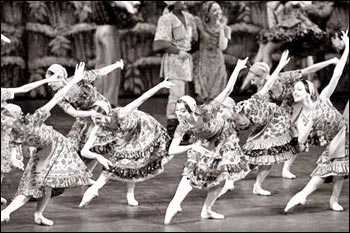Bolshoi Ballet: Dancing from the Soul
Yulia Edirisinghe
Ballet. No sooner than you hear it, the word is almost synonymous in
your mind with Russia… and vice versa.
Ballet is an art without words; it is the expression of events,
ideas, feelings and emotions through the subtleties and complexities of
movement. It’s an art form that is unique, creating its history by word
of mouth. It is a continuity of tradition: the passing down of skill,
knowledge and experience gained by dancers, ballets masters and teachers
through the ages, being handed down from one generation to the next.
|

Scene from an old favourite, Don Quixote, which was first
presented in December 1869. |
Russian Ballet is a phenomenon greater than the country or the art
form themselves. Once described by Russian poet, Alexander Pushkin, as
“a dance executed by the human soul”, Russian Ballet represents the
feeling and sentiments of the many hundreds of people, throughout its
history, who have contributed to the evolution of the art, distilled by
the incredible talents and genius of choreographers and young dancers.
The style conveys the unique national character of the world’s
largest country. Its fundamental link with various forms of folk dance
highlights the profoundly lyrical quality of the Russian woman, who
serves essentially as the muse for Russian Ballet. And it is she who
inspires in it, its exceptional charm and irresistible appeal.
Ballet, which was uniquely Russian, was born at the St. Petersburg
School of Choreography and shaped to what it is today by the Moscow
State Academy of Choreography, which serves as the exclusive school for
the Bolshoi Ballet Company, one of the best in the world.
The Bolshoi ballet, which visited Sri Lanka in 2004, upon the
invitation of the Russian Centre in Colombo is currently in their 234th
season of performance. Throughout this exceptional length of artistic
distinction, some things still remain the same, for instance, its
unfailing adherence to the principles of classical dance. In this
regard, Mikhail Fokine, regarded as the best known choreographer of the
20th century, wrote: “Modern ballet companies should derive their
inspiration from the unfading works created by their classical
predecessors […] in order to carry them on and add a modern dimension to
them”.
The strength of classical dance that the Bolshoi holds so dear is its
ability to evolve, to absorb new intonations and elements from the
contemporary scene.
The Bolshoi we see today stands true to the classics which gave it
its signature, but more than two hundred years stronger. Time has
introduced new elements and adjustments, particularly the greater
attention given to the human personality with all of its contradictions
and complexities.
An episode of change for the Bolshoi happened, like for so many
things in Russia, during the period of the post revolutionary years. The
doors of the theatre were thrown open for the working class audience and
the Bolshoi found themselves diversifying its thematic range beyond the
traditional world of fairytale to include new subjects and new heros. By
the first anniversary of the October Revolution, the Bolshoi presented
Glazunov’s Stenka Razin, the first ballet the heroic theme.
|

The Bolshoi Ballet performs Bright Stream. |
Today, this theme has established a remarkable dominance over the
Bolshoi ballet’s repertoire.
Conveying a message of courage, dynamism and impassioned emotionality
is and always has been an iconic tradition of the Bolshoi ballet. This
tradition has been exemplified by the many heroic ballets that have been
presented since the post revolutionary years. The challenge of ballets
of this theme is its emphasis on the inner world or psychology of the
hero rather than merely the storyline. Dancers must relate not only the
actions of the characters they play, but also lay bare the motives
behind their actions. As a result, ballet has become an increasingly
intellectual art, emphasizing a harmonious blend of dance and poetry.
These ballets have enabled the stars dancers of the company to reveal
every facet of their talent, making the Bolshoi ballet stand out as
second to none. Its dancers exhibit such a high professional standard
that hardly any other ballet company can challenge its leadership.
The excellence of the Bolshoi tradition stands unwavering, rendered
immortal by the deceptively effortless movement, choreographed and
executed to perfection, holding audiences across the world captive for
more than two centuries.
The writer is a former student of the Russian School of Ballet and
Dancing and has studied ballet for ten years. She was part of the corps
de ballet during the Bolshoi ballet’s visit to Sri Lanka. |



